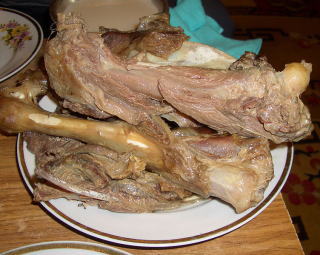If you are traveling to Mongolia, Leave it to a local professional travel agency
MONGOLIAN TRADITIONAL FOODS
UUTS OR WHOLE RUMP OF A SHEEP


MONGOLIAN TRADITIONAL FOOD UUTS OR WHOLE RUMP OF A SHEEP. The whole rump of a sheep is boiled/steamed in a big pot along with the other parts, head, and legs. Uut is the most famous dish of the traditional holiday Lunar New Year, traditional parties and festivals.


Mongolian Airag is a fermented dairy product traditionally made from mare’s milk. It has a unique and slightly sour flavor with a bite from the mild alcoholic content; serving it is an essential part of Mongolian hospitality. It Airag will be ready after many times of beating the mix of horse milk – the source of airag is reserved for just this in a hohuur (big leather container). Airag requires at least 2000-4000 beats which help it to ferment with air. The culture of fermenting airag in Khukhuur was inscribed on the Representative List of the Intangible Cultural Heritage of Humanity by UNESCO in 2019. In Mongolia, the milking season for horses traditionally runs between mid-June till early October.
Suutei Tsai (Milk Tea)


Mongolian Nomad’s hospitality starts from offering milk tea to every visitor. The main ingredients of milk tea are tea (typically from southern China, Georgia, and Sri Lanka), milk, and a little bit of salt. Milk tea is the most commonly consumed beverage in Mongolia and during holidays such as Lunar New Year and Naadam, all families must prepare milk tea to offer guests.


KHUUSHUUR


Mongolian Khuushur is a meat pastry or what westerners refer to as meat
pockets. Khuushuur is quite common food at most cafés and restaurants across
Mongolia. Mongols celebrate the National Naadam Festival in July and August
and it’s during the Naadam Festival that the main foods are khuushuur and
Mongolian Barbecue that is called Khorkhog. The main ingredients are minced
meat, onion, garlic, salt, and spices – though Khuushuur with alpine wild
leeks or wild onions is popular in Mongolia.


Another common dish you’ll encounter in every Mongolian family household
or in the menu of a local restaurant or diner is Tsuivan (Цуйван). It’s
a kind of fried mixture of steamed noodles, meat, and vegetables. The Tsuivan
is a really easy-to-make dinner, that probably each household prepares
several times a month.




A hearty meal, Khorkhog (Хорхог) consists of big mutton pieces, some vegetables
like potatoes & carrots, sometimes steamed Mongolian noodles, and heated
river stones. It is a festive and family meal consumed more commonly in
the countryside during trips, or during a visit to a family of nomads on
the steppes.


Mongolian “Aaruul” is a dried curd (called aaruul in Mongolian) that is the most widely consumed traditional dairy product in Mongolia. During the summer, nomadic families milk animals (mainly cows, sheep, yaks, and camels) twice a day to make plenty of aaruul and other dairy products to consume year-round. Nomads usually make aaruul from goat and cow’s milk.
BUDAATAI KHUURGA

Stew with rice, vegetables, and meat.
To eat Mongolian can sometimes also remind us of China. Since the old times, rice was imported from the southern neighbors, because it obviously doesn't grow in the Mongolian climate.
BOORTSOG


It would seem that this Mongolian pastry is nothing special. In essence, the boortsog is a small, delicious donut that is served as an appetizer for tea.The “right” boortsog is deep-fried until golden brown, using animal fat (although in the modern world it is increasingly being replaced by vegetable oil). They are often sprinkled with powdered sugar or sprinkled with liquid honey. Incredibly tasty, especially with tea. Boortsog can be of various shapes and sizes, especially a lot of this baking is being prepared for the holiday Tsagan Sar.
BANTAN


National Mongolian soup with the simplest composition. It is prepared on
a strong meat broth from lamb or beef. Additionally, add a little flour
and vegetables to make it more satisfying, but not to interrupt the natural
taste of meat. Of the spices, only salt and pepper are put in the traditional
Mongolian soup. If bantan is made from lamb, sometimes milk is added to
the broth to make the dish more tender. In Mongolia, this soup is considered
medicinal.
Guriltai Shol


Mongolian Noodle Soup is a hearty soup with meat and noodles that are commonly
consumed in the cold months. Most family prepares the bone broth (simmering
lamb or beef) and then adds hand-made noodles with chopped onion. Mongolian
foods generally don’t rely on a lot of spices and herbs due to the extreme
continental climate. But people in central places lately prefer to add
some vegetables such as potatoes, carrots, and cabbage to noodle soup.
Chanasan Mah 


It’s a slow-cooked meat in a broth, seasoned with onions and salt, then
added vegetables and wide noodles. The meat is commonly mutton and beef
but can be goat or horse sometimes. After everything is done cooking, the
tender meat and the vegetables are put on a platter and served, with the
broth in a different bowl. Basically, it’s a deconstructed noodle soup.




